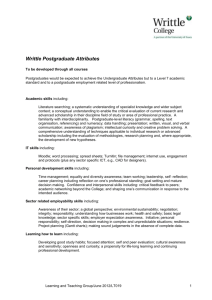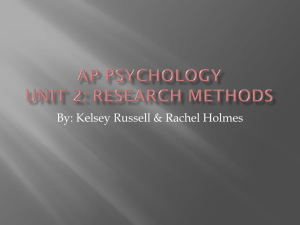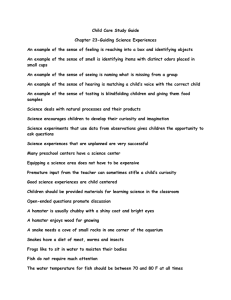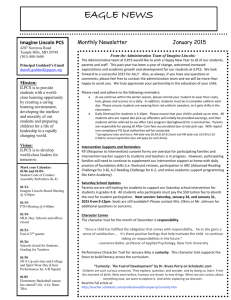curiosity as a feeling of interest and feeling of
advertisement
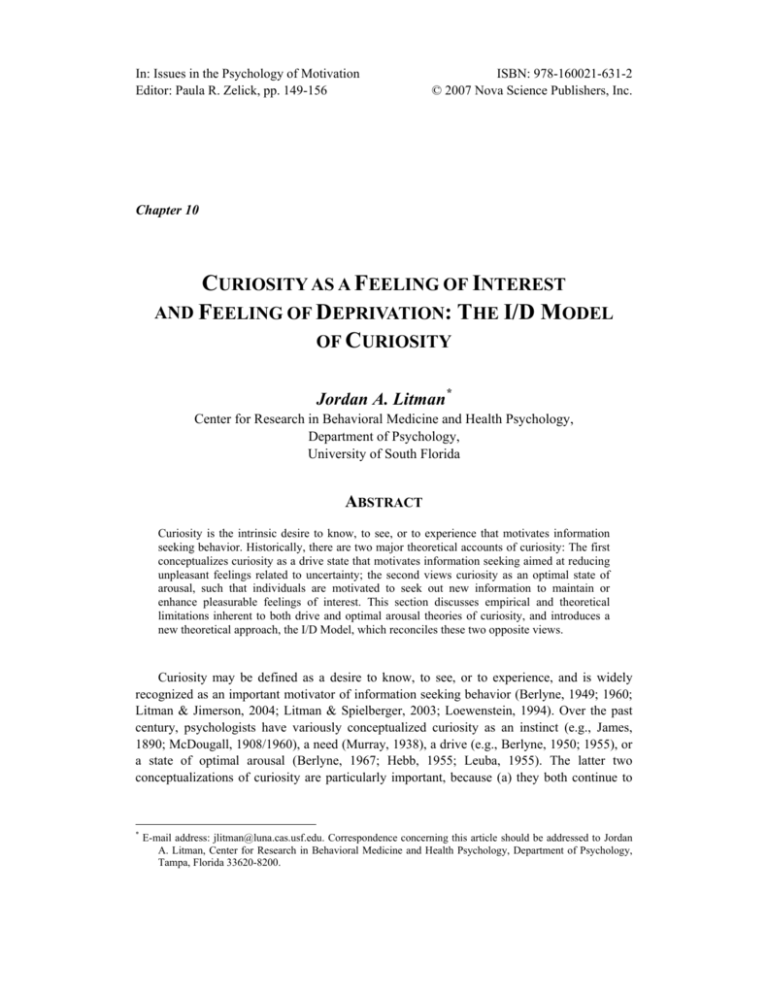
In: Issues in the Psychology of Motivation Editor: Paula R. Zelick, pp. 149-156 ISBN: 978-160021-631-2 © 2007 Nova Science Publishers, Inc. Chapter 10 CURIOSITY AS A FEELING OF INTEREST AND FEELING OF DEPRIVATION: THE I/D MODEL OF CURIOSITY Jordan A. Litman* Center for Research in Behavioral Medicine and Health Psychology, Department of Psychology, University of South Florida ABSTRACT Curiosity is the intrinsic desire to know, to see, or to experience that motivates information seeking behavior. Historically, there are two major theoretical accounts of curiosity: The first conceptualizes curiosity as a drive state that motivates information seeking aimed at reducing unpleasant feelings related to uncertainty; the second views curiosity as an optimal state of arousal, such that individuals are motivated to seek out new information to maintain or enhance pleasurable feelings of interest. This section discusses empirical and theoretical limitations inherent to both drive and optimal arousal theories of curiosity, and introduces a new theoretical approach, the I/D Model, which reconciles these two opposite views. Curiosity may be defined as a desire to know, to see, or to experience, and is widely recognized as an important motivator of information seeking behavior (Berlyne, 1949; 1960; Litman & Jimerson, 2004; Litman & Spielberger, 2003; Loewenstein, 1994). Over the past century, psychologists have variously conceptualized curiosity as an instinct (e.g., James, 1890; McDougall, 1908/1960), a need (Murray, 1938), a drive (e.g., Berlyne, 1950; 1955), or a state of optimal arousal (Berlyne, 1967; Hebb, 1955; Leuba, 1955). The latter two conceptualizations of curiosity are particularly important, because (a) they both continue to * E-mail address: jlitman@luna.cas.usf.edu. Correspondence concerning this article should be addressed to Jordan A. Litman, Center for Research in Behavioral Medicine and Health Psychology, Department of Psychology, Tampa, Florida 33620-8200. 150 Jordan A. Litman influence theory and research on curiosity today, and (b) they are almost completely opposite in their assumptions about how curiosity motivates behavior. Curiosity-drive theory (CDT) advances the notion that information-seeking is mediated through curiosity-reduction. In essence, CDT equated curiosity to relatively unpleasant experiences of “uncertainty” triggered by encounters with novel, complex, or ambiguous stimuli. The reduction of aversive curiosity states was hypothesized to be rewarding. Numerous studies demonstrated that the presentation of new or unusual stimuli (e.g., objects, pictures, puzzles) motivated investigatory behavior from humans and animals. Once new information had been obtained, investigation would cease, indicating that uncertainty had been satisfactorily resolved (Berlyne, 1954; 1955; 1957; 1958). CDT provided a simple and powerful explanation for why individuals were motivated to learn new information – it was to reduce uncomfortable states of uncertainty. However, CDT had a fatal flaw: A number of studies demonstrated that animals and humans often initiated exploratory behaviors before anything new or unusual was presented (Brown, 1953; Butler, 1957; Harlow, 1953; Hebb, 1958). These behaviors suggested that in the absence of novel or complex stimulation, animals and humans were motivated to seek it out. If being curious was unpleasant, it wasn’t clear why organisms would look for opportunities to have their curiosity aroused (Berlyne, 1966; Fowler, 1966; Hebb, 1955)1. An alternate account was developed that viewed curiosity as a consequence of seeking an optimal level of physiological arousal (Berlyne, 1967; Hebb, 1955; Leuba, 1955). Optimal Arousal Theory (OAT) of curiosity was based on the view that when organisms were bored (i.e., under-aroused) they were motivated to explore their environment in search of stimuli or events that might excite their curiosity (e.g., novel or complex sights, sounds, or events), generate positive feelings of interest, and thereby increase their arousal to an optimal level (Dember & Earl, 1957; Fowler, 1965; Harlow, 1954; Hebb, 1955). According to OAT, in situations where stimulation was too intense (i.e., extremely new or unusual), uncomfortably high levels of physiological arousal were experienced, which motivated avoidance behavior. Of course, based on this view, after new information had been obtained, boredom was assumed to quickly return, which would motivate organisms to seek new stimulation once again. While OAT’s curiosity-induction hypothesis provided an answer as to why organisms might voluntarily seek to arouse their curiosity, it could not explain why anyone would want to acquire new information if it returned them to undesirable states of boredom. If being perpetually curious was an ideal state of affairs, why would anyone ever try to learn anything new? 2\2 RECONCILING REDUCTION AND INDUCTION THEORIES OF CURIOSITY: THE I/D MODEL OF CURIOSITY Litman and Jimerson (2004) posited that a fundamental limitation of CDT and OAT was a failure to consider the possibility both the reduction and induction of curiosity could 1 2 See Berridge (2001) for further discussion of the limitations of drive reduction as an explanatory construct. See Neiss (1988), Winton (1987), and also Woodman and Hardy (2001) for further commentary on the limitations of general arousal and optimal arousal models. The I/D Model of Curiosity 151 motivate information seeking behavior. According to Litman and Jimerson (2004), curiosity can be aroused when individuals discover an opportunity to learn something of potential interest (I-type) and also when they feel uncomfortably deprived of information and need to eliminate their ignorance (D-type). When I-type curiosity is stimulated, obtaining new information is rewarding because it induces positive feelings of interest; for D-type curiosity, acquiring new information is rewarding because it reduces negative feelings related to uncertainty. I-type curiosity corresponds with situations where individuals do not feel they are missing any information per se, but recognize an opportunity to learn something that may be entertaining or amusing. In contrast, D-type curiosity is activated in situations when individuals feel they are lacking information that is considered essential to improving their understanding. Litman (2005) theorizes that the different subjective experiences and underlying reward mechanisms associated with I- and D-type curiosity can be best understood in terms of Berridge’s (1999; Berridge & Robinson, 1998) concepts of “wanting” and “liking”, which are two neural systems that appear to underlie affective experience and motivation for a wide range of appetites. Wanting refers to the activation of mesolimbic dopamine circuits, and is experienced as need or desire. Liking involves opioid activity in the nucleus accumbens and is implicated in both the anticipation and experience of pleasure. High wanting reflects an unsatisfied need state while high liking can be equated to satisfaction or delight. Berridge’s research suggests that wanting and liking are correlated but dissociated processes, such that activity of one system is relatively independent of the other (see Berridge, 2003a for a review). In many situations, wanting and liking will correspond quite closely, such that desire and anticipated pleasure are of nearly equal magnitude. However, there are also times when desire and expected reward can be markedly disproportionate to one another (Berridge, 2003b; 2004) For example, eating food to reduce hunger pangs and satisfy nutritional deficits will reinforce consumatory behavior, but eating can also be pleasurable in the absence of deficiency – that is, humans and animals may eat purely for reasons of pleasurable stimulation (Cornell, Rodin, & Weingarten, 1989). The first case describes a condition of both high wanting and high liking, whereas the second example reflects relatively low wanting but high liking. According to Litman (2005), a condition of high wanting and high liking is quite similar to the concept of D-type curiosity, when the lack of information is perceived as a deficiency that requires satisfaction, while a combination of low wanting and high liking is consistent with the concept of I-type, in which information seeking is motivated purely by the anticipation of increased enjoyment.3 These qualitative differences between I- and D-type curiosity are theorized to result in important quantitative differences in the expression of curiosity: Because D-type curiosity involves an unsatisfied need-like state, it is hypothesized to correspond with more intense experiences of curiosity than I-type curiosity, and therefore motivate more information seeking. 3 See Litman (2005) for a discussion of other possible combination of high and low levels of wanting and liking that are relevant to curiosity and information seeking. 152 Jordan A. Litman DETERMINANTS OF I- AND D-TYPE CURIOSITY Litman and colleagues (2005; Litman & Jimerson, 2004; Litman & Spielberger, 2003) hypothesize that a combination of dispositional and situational factors contributes to the stimulation of I- and D-type curiosity. Building on the State-Trait theory of emotion and personality (Spielberger, Ritterband, Sydeman, Reheiser, & Unger, 1995), which predicts that individuals characterized by high levels of a given trait will experience corresponding emotional-motivational states more intensely, Litman and Jimerson (2004) theorize that there are also important individual differences in the experience and expression of I- and D-type curiosity. While there are several trait measures of I-type curiosity already in existence (See Litman & Silvia, 2006 for a review), which inquire about enjoyment in learning new things, Litman and Jimerson (2004) noted that there did not appear to be a clear D-type curiosity measure that emphasized uncertainty reduction as a motive for seeking new information. They developed a 15-item Curiosity as a Feeling-of-Deprivation (CFD) scale, comprised of items that refer to desiring new information to reduce feelings of tension or frustration caused by uncertainty (e.g., "It bothers me if I come across a word that I don’t know, so I will look up its meaning in a dictionary”; “I feel frustrated if I can’t figure out the solution to a problem, so I work even harder to solve it”). Although the CFD scale is moderately positively correlated with I-type curiosity instruments, confirmatory factor analyses have shown support for differentiated I- and D-type curiosity dimensions (Litman & Jimerson, 2004; Litman & Silvia, 2006). As to the situational determinants of each type of curiosity, Loewenstein (1994) suggested that D-type curiosity was associated the elimination of discrepancies (i.e., information-gaps) within a set of inter-related knowledge, whereas seeking information purely to stimulate one’s interest (i.e., I-type) was involved when no deficiency was perceived. This view implies that D-type curiosity is aroused when individuals already have at least some information in their repertoire, discover that a relevant piece of information is missing, and want to include it in the knowledge set. In contrast, I-type reactions would be expected when individuals have little or no prior information, and therefore do not have a well defined knowledge set that could be seen as incomplete. In a recent study, Litman, Hutchins, and Russon (2005) asked participants whether they knew the answers to a series of general knowledge questions, and examined the relationships between individual differences in I- and D-type curiosity, state-curiosity, metacognitive evaluations of one’s prior knowledge, and information seeking behavior. Consistent with their expectations, path analyses indicated that trait-curiosity predicted levels of state-curiosity, which in turn predicted subsequent information seeking. However, the relationships between trait measures of I- and D-type curiosity and state-curiosity depended on participants’ judgments about whether they did or did not know the answers. When participants reported that they didn’t know the answer, state-curiosity was only significantly associated with I-type curiosity, as measured by Litman and Spielberger’s (2003) Epistemic Curiosity scale. However, when participants indicated that the unknown answer was on the tip of their tongue, only D-type curiosity, as measured by the CFD scale (Litman & Jimerson, 2004), predicted the intensity of curiosity states. When participants knew the answer, they engaged in the least information seeking, and these behaviors were The I/D Model of Curiosity 153 unrelated to either I- or D-type curiosity, suggesting that information seeking had been due to accuracy checking rather than interest induction or discrepancy reduction. Moreover, mean state-curiosity scores associated with D-type curiosity were significantly greater than those associated with I-type and also corresponded with significantly more information seeking behavior. Taken together, these findings were quite consistent with the I/D model of curiosity. DIRECTIONS FOR FUTURE RESEARCH The I/D model reconciles the seemingly incompatible reduction (CDT) and induction (OAT) theories of curiosity, by positing that curiosity can involve both seeking out information expected to be interesting (I-type) as well searching for missing information that will resolve uncertainty (D-type). It will be important in future research to examine whether there are distinctive physiological markers associated with I- and D-type curiosity that correspond with different affective expressions of “interest” or “deprivation” (e.g., Ekman, 1992; Izard, 1990). This would provide further evidence that I-and D-type curiosity are meaningfully distinct experiences, as is suggested by research on the factor structure of curiosity measures (Litman & Jimerson, 2004; Litman & Silvia, 2006). Litman (2005) suggests that the different affective experiences associated with I- and Dtype curiosity can be understood in terms of varying activation of dopamine (wanting) and opioid (liking) circuits in the brain. While a number of animal studies have shown that both dopaminergic and opioid systems are implicated in approaching and inspecting novel stimuli (e.g., Bevins, Besheer, Palmatier, Jensen, Pickett, & Eurek, 2002; Dulawa, Grandy, Low, Paulus, & Geyer, 1999; Ikemoto & Panksepp, 1999, Panksepp, Knutson & Burgdorf, 2002; Lukaszewska & Klepaczewska, 1997), in future research it will be important to investigate whether Litman’s (2005) specific hypotheses about I- and D-type curiosity and levels of wanting and liking hold true. Recent research suggests that I- and D-type curiosity each contributes to the motivation of information seeking behavior under different sets of circumstances (Litman et al, 2005). Itype curiosity appears to be activated when we feel we feel we have a complete lack of information about something (i.e., a “don’t know” state), whereas D-type curiosity seems to be involved when individuals believe they have some information relevant to a specific target, though they are unable to produce the target (i.e., a tip-of-the-tongue experience). Thus, the relationships between I- and D-type curiosity and information seeking are dependent on specific metacognitive evaluations about what one does or does not know. These findings raise questions about differences in the underlying processes involved in “don’t know” and tip-of-the-tongue (TOT) states, which will be important to investigate in future studies. In conclusion, the I/D model of curiosity suggests a number of new and fruitful directions for future research that may help clarify the complex nature of curiosity as an emotionalmotivational state, and reveal much about the factors that underlie information seeking behavior. 154 Jordan A. Litman REFERENCES Berlyne, D.E. (1949). Interest as a psychological concept. British Journal of Psychology, 39, 184-185. Berlyne, D. E. (1950). Novelty and curiosity as determinants of exploratory behavior. British Journal of Psychology, 41, 68–80. Berlyne, D. E. (1954). A theory of human curiosity. British Journal of Psychology, 45, 180-191. Berlyne, D. E. (1955). The arousal and satiation of perceptual curiosity in the rat. Journal of Comparative and Physiological Psychology, 45, 180-191. Berlyne, D.E. (1957). Determinants of human perceptual curiosity. Journal of Experimental Psychology, 53, 399-404. Berlyne, D.E. (1958). The influence of complexity and novelty in visual figures on orienting responses. Journal of Experimental Psychology, 55, 289-296. Berlyne, D. E. (1960). Conflict, arousal, and curiosity. New York, NY: McGraw-Hill. Berlyne, D. E. (1966, July). Curiosity and exploration. Science, 153, 25-33. Berlyne, D. E. (1967). Arousal and reinforcement. In D. Levine (Ed.), Nebraska symposium on motivation (pp. 1-110). Lincoln, NE: University of Nebraska Press. Berridge, K.C. (1999). Pleasure, pain, desire, and dread: hidden core processes of emotion. In D. Kahneman, E. Diener, & N. Schwarz, (Eds.), Well-being: Foundations of hedonic psychology. New York: Russell Sage Foundation, pp 527-559. Berridge, K.C. (2001). Reward learning: Reinforcement, incentives and expectations. In D. L. Medin (Ed.), Psychology of learning and motivation, (Vol. 40, pp. 223-278). Orlando, FL: Academic Press. Berridge, K. C. (2003a). Pleasures of the brain. Brain & Cognition, 52, 106-128. Berridge, K.C. (2003b). Irrational pursuits: Hyper-incentives from a visceral brain. In I. Brocas & J. Carrillo (Eds.), The psychology of economic decisions (Vol. 1, pp. 17-40). Oxford University Press. Berridge, K. C. (2004). Pleasure, unfelt affect and irrational desire. In A.S.R. Manstead, A.H. Fischer & N. Frijda (Eds.), Feelings and Emotions: The Amsterdam Symposium, (pp. 4362). Cambridge University Press. Berridge, K.C. & Robinson, T.E. (1998). The role of dopamine in reward: Hedonics, learning, or incentive salience? Brain Research Reviews, 28, 308-367. Bevins, R. A., Besheer, J., Palmatier, M. I., Jensen, H. C., Pickett, K. S., & Eurek, S. (2002). Novel-object place conditioning: behavioral and dopaminergic processes in expression of novelty reward. Behavioural Brain Research, 129, 41–50. Brown, J. S. (1953). Problems presented by the concept of acquired drives. In Current theory and research in motivation (pp. 49-54). Lincoln, NE: University of Nebraska Press. Butler, R. A. (1957). The effect of deprivation of visual incentives on visual exploration motivation in monkeys. Journal of Comparative & Physiological Psychology, 48, 247-249. Cornell, C., Rodin, J., & Weingarten, H. (1989). Stimulus-induced eating when satiated. Physiology and Behavior, 45, 695-704. Dember, W. N. & Earl, R. W. (1957). Analysis of exploratory, manipulatory, and curiosity behaviors. Psychological Review, 64, 91-96. The I/D Model of Curiosity 155 Dulawa, S. C., Grandy, D. K., Low, M. J., Paulus, M. P. & Geyer, M. A., (1999). Dopamine D4 receptor-knock-out mice exhibit reduced exploration of novel stimuli. Journal of Neuroscience, 19, 9550–9556. Ekman, P. (1992). An argument for basic emotions. Cognition & Emotion, 6, 169-200. Fowler, H. (1965). Curiosity and exploratory behavior. New York: Macmillan. Harlow, H. F. (1953). Mice, monkeys, men, and motives. Psychological Review, 60, 23-32. Harlow, H. F. (1954). Learning theory, personality theory, and clinical research. In Kentucky Symposium (Vol. 9, pp. 36-53). Oxford, England: John Wiley & Sons. Hebb, D. O. (1955). Drives and the C. N. S. (conceptual nervous system). Psychological Review, 62, 243-254. Hebb, D. O. (1958). The motivating effects of exteroceptive stimulation. American Psychologist, 13, 109-113. Ikemoto, S., & Panksepp, J. (1999). The role of the nucleus accumbens dopamine in motivated behavior: A unified interpretation with special reference to reward-seeking. Brain Research Reviews, 31, 6–41. Izard, C. E. (1990). Facial expressions and the regulation of emotions. Journal of Personality & Social Psychology, 58, 487-498. James, W. (1890). The principles of psychology. New York, NY: Holt, 428–430. Koriat, A. (1998). Metamemory: The feeling of knowing and its vagaries. In M. Sabourin & F. Craik (Eds.) Advances in psychological science (Vol. 2: Biological and cognitive aspects, pp. 461-479). Hove, England: Psychology Press/Erlbaum. Leuba, C. (1955). Toward some integration of learning theories: The concept of optimal stimulation. Psychological Reports, 1, 27-33. Litman, J.A. (2005). Curiosity and the pleasures of learning: Wanting and liking new information. Cognition and Emotion, 19, 793-814. Litman, J. A., & Jimerson, T. L. (2004). The measurement of curiosity as a feeling-ofdeprivation. Journal of Personality Assessment, 82, 147–157. Litman, J. A., Hutchins, T. L., & Russon, R. K. (2005). Epistemic curiosity, feeling-ofknowing, and exploratory behaviour. Cognition and Emotion, 19, 559-582. Litman, J.A. & Silvia, P. J. (2006). The latent structure of trait curiosity: Evidence for interest and deprivation curiosity dimensions. Journal of Personality Assessment, 86, 318-328. Litman, J. A., & Spielberger, C. D. (2003). Measuring epistemic curiosity and its diversive and specific components. Journal of Personality Assessment, 80, 75-86. Loewenstein, G. (1994). The psychology of curiosity: a review and reinterpretation. Psychological Bulletin, 116, 75-98. Lukaszewska, I. & Klepaczewska, A. (1997). The effect of naloxone on object exploration, object recognition and other types of spontaneous behavior. Acta Neurobiologiae Experimentalis, 57, 123-133. 68–76. Maril A, Wagner A, Schacter D. (2001). On the tip of the tongue: an event-related fMRI study of semantic retrieval failure and cognitive conflict. Neuron 2001, 31, 653–60. McDougall, W. (1908/1960). An introduction to social psychology. London: Methuen. Murray, H. A. (1938). Explorations in personality. New York: Oxford University Press. Neiss, R. (1988). Reconceptualizing arousal: Psychobiological states in motor performance. Psychological Bulletin, 103, 345-366. 156 Jordan A. Litman Panksepp, J., Knutson, B., & Burgdorf, J. (2002). The role of brain emotional systems in addictions: a neuro-evolutionary perspective and new ‘self-report’ animal model. Addiction, 97, 459–469. Schwartz, B. L., Travis, D. M., Castro, A. M., & Smith, S. M. (2000). The phenomenology of real and illusory tip-of-the-tongue states. Memory & Cognition, 28, 18–27. Spielberger, C. D., Ritterband, L. M., Sydeman, S. J., Reheiser, E.C., & Unger, K. K. (1995). Assessment of emotional states and personality traits: Measuring psychological vital signs. In J.N. Butcher (Ed.). Clinical personality assessment: Practical approaches (pp. 42-57). Oxford University Press. Winton, W. M. (1987). Do introductory textbooks present the Yerkes-Dodson Law correctly? American Psychologist, 42, 202-203. Woodman, T. & Hardy, L. (2001). Stress and anxiety. In R. N. Singer, N. A. Hausenblas & C. M. Janelle (Eds.), Handbook of sport psychology (pp. 290-318). New York: Wiley.

